How to add a cement/concrete patio extension?
Related Discussions
How can I put wood tiles or deck on slightly sloped concrete patio?
The large patio outside my condo has a slight slope to help with drainage but it's ugly and I want to put a wood deck or interlocking deck tiles over it. the concrete... See more
How to remove dark spots from new concrete patio?
We just had a new concrete patio poured yesterday morning. I asked the contractor before he left if we needed to worry about rain. He said no. It did start to rain... See more
How to clean dog pee off of our cement patio
Our dog refuses to pee on the grass, so I am cleaning our patio daily and the smell seems to linger. No matter what I use I can still smell this unpleasant order.
How to give old concrete patio an inexpensive, long-lasting facelift?
The concrete on my patio is awful. It is the focal point of my backyard. Pressure washing doesn't last long. It is uncovered, so it gets all of the yearly weather. ... See more





What size extension? Have you done this type of work, before? You'll most likely need rebar in the cement, for added strength.
Attempt to do it! I mean I just prefer doing things myself and it wasn’t so hard compared to some projects its worth a shot
IF you have not done concrete before.... hire it done (HomeAdvisor.com or Angieslist.com) and BE THERE... watch how they prep, watch how they pour, and watch how they finish.... ask them to show you how. FYI.. higher temperatures make the pour cure too fast, especially for small areas.... if you can.... wait until the temps will be in the 70's for several days in a row (on the days you pour)
Pouring concrete is an art. While I am all for diy, this is too large of a project for a first timer. There is a lot of prep work involved before you can even think about pouring. For such a large expanse, I wouldn't chance it. Check local building codes as to how far down you need to dig, what mix you need to use., etc. It varies across the country. I would just video each step, and shadow the concrete installer so that you can start to tackle small projects on your own.
Forget the concrete, professional, and save your money for real projects. Just use pavers to extend the patio and you can do it yourself.
https://www.homedepot.com/c/how_to_install_a_paver_patio_HT_PG_OD
https://www.wikihow.com/Install-Pavers
If you don't mind some hard work you can do this yourself. Determine the size you want the area to be and mark out using paint. you then should remove all grass and topsoil from the area to approx. 8 to 12 inches deep depending on what your soils below are. After the area is prepared you will then need to install a compact-able stone base for the patio stone. A vibratory plate compactor (can be rented) is best to compact the stone base. Spread the stone out in thin layers and water until the compactor almost gets struck using it. Then add the next layer of stone and repeat until getting to the needed thickness, thickness of the pavers being used, an inch of sand bedding to set the pavers equals the depth below finished grade for the stone base. Make sure to slope the patio away from the house so rainwater doesn't pool against the house. This Old House website should have a few videos on how to proceed. Good Luck.
you will get the best results if you bust up and remove the old patio. stake out the size you want. dig down the existing soil to a 4 inch depth. you will need to drill into the side of the existing house slab so you can insert rebar rods rods that will extend into your new slab patio. this will prevent your new patio from separating away from your house. Then get some highway mesh and cut it to size. lay small pieces of bricks under the mesh to raise it off the ground about two inches. Stake and frame the sides of your new patio with wood framing stakes and 1 x 4 boards. make sure your frame is sturdy because cement is heavy! don't forget to slope the frame away from your house to keep rainwater off your patio.Cement work is heavy work. your success depends on your prep work. Take your time. This is a big job. If you've never floated cement before, call in a professional. Most of the work is in the prep. If you prep it properly, call the professional in to make the pour and float it for you. Good Luck!
Why not just add more pavers, of a contrasting design.
Seems like a lot of work, but once you get on a roll it goes fast. Also the satisfaction of your own layout, money saved, doing it how you want, and the pride of the finished project.